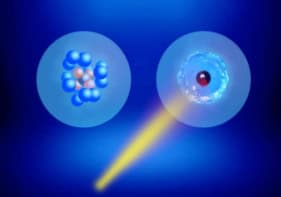A would-be explanation for the quantum phase of matter known as a supersolid has been ruled out by a new experiment. Physicists in the US have found evidence for supersolidity in single crystals of helium-4, thus showing that the phase does not require superfluid grain boundaries to exist, as some had thought (arXiv.org/abs/0706.0906).
Supersolidity was first predicted in 1969 by Russian theorists Alexander Andreev and Ilya Liftshitz. They said that lattice vacancies, which usually only occur at finite temperature, could still exist at temperatures close to absolute zero in weakly-bound elements such as helium due to quantum “zero point” energy. By cooling solid helium to low temperatures, these vacancies could all collapse into the same ground state, becoming what is known as a Bose-Einstein condensate (BEC). In this supersolid state, vacancies would behave as a coherent entity, moving throughout the rest of the solid effortlessly like a superfluid.
In 2004, Moses Chan of Pennsylvania State University in the US was the first to find evidence for supersolidity when he and his graduate student Eun-Seong Kim noted a small change in the rotational inertia of a sample of helium-4 supported inside a torsion oscillator below a temperature of 230 mK. This, they concluded, meant 1% of the sample had remained at rest in the lab frame by condensing into a supersolid. But according to a more recent theory, that strength of supersolid signal would not be possible from zero-point vacancies alone, and so is not explainable by Andreev and Liftshitz’s original theory.
Earlier this year, Nikolay Prokofev and Boris Svistunov of the University of Massachusetts and several others suggested that Kim and Chan’s results – and other supersolid signals found since then by other groups – could be coming from superfluid grain boundaries. These are defects just three atoms wide that separate regions of different crystal orientation. But now Chan – this time with graduate students Anthony Clark and Joshua West – has ruled out this possibility by repeating his experiment with single crystals of helium-4, which contain no grain boundaries
To ensure that he was working with single crystals, Chan managed to “seed” the growth of solid helium at a cold spot within the torsion oscillator. “We can be confident that our samples are single crystals or at worst comprise just a few large crystals in the sample cell,” he said. He used two oscillators: one for samples of commercially pure helium-4 (containing 300 parts per billion helium-3) and the other for “isotopically” pure helium-4 (containing one part per billion helium-3).
Chan’s group found that single helium crystals still gave a supersolid signal, albeit reduced. They also found that samples of the purer, isotopic helium-4 had a stronger signal than samples containing the commercially pure grade. To see if this was actually an effect of purity, they added helium-3 to the purer helium-4 samples, but the signal remained just as strong.
Chan told Physics Web that he suspects dislocations are the cause of supersolidity, and that the stronger signal from the purer sample could be due to the differences between the two torsion oscillators affecting the crystallization of the helium. “All we can say is that in a single, solid crystal we still see [a supersolid signal], and it is not due to grain boundaries,” he said. “But why there is still a variation in [the signal], we don’t really know.”



